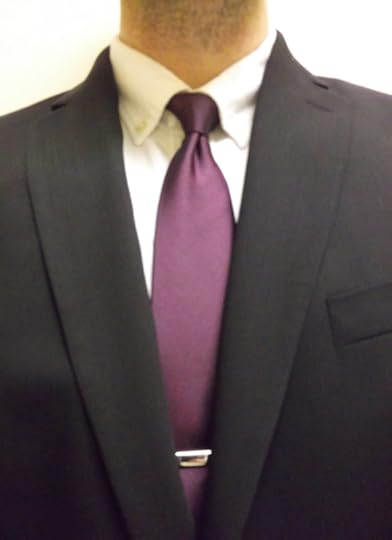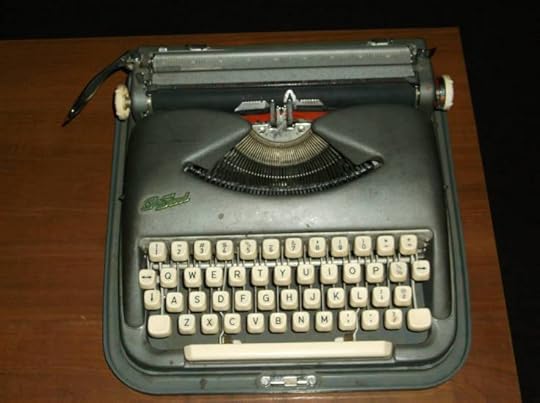David Michael Newstead's Blog, page 118
October 25, 2015
Statement Socks
By David Michael Newstead.
If you’ve bought clothes in the last few years, you might have noticed the changing look of men’s socks. Crazy eye-catching patterns and bright colors have brought some trendiness to an article of clothing that has essentially been one muted color for a long time. Recently, I even saw dress socks for sale in Macy’s that depicted the famous painting The Woman in Gold by Gustav Klimt, which isn’t exactly subtle. But far from being a trend solely for young professionals and well-dressed entrepreneurs, the rise of statement socks has included people like 91-year-old former Republican President George H. W. Bush. On father’s day this year, I saw a mother and daughter reading the newspaper, stopping to excitedly point out an ad for matching statement socks for sons and fathers. And around the workplace, the trend is becoming more and more visible. To better understand this universal appeal, I turned to the most well-dressed guy I know – my friend Nikhil Patil – to discuss the rise of statement socks.
David Newstead – So, Nikhil. Colorful socks… What’s the deal?
Nikhil Patil – What’s the deal? They’re socks. Something to keep your feet warm and prevent your shoes from smelling.
David Newstead – But I mean, colorful dress socks. Statement socks.
Nikhil Patil – It’s a bit like wearing a superhero costume underneath your formal suit
David Newstead – Nice analogy. I often do both.
Nikhil Patil – It’s a way to express a bit about who you are and your personality, while still remaining professional. Most men’s dress pants run to their shoes, so if a man is standing normally. Then, you won’t see his socks. But it’s when he moves, maybe lifts a leg, the pant rides up, and you can catch a quick flash of color.
Nikhil Patil – While it’s pretty acceptable to wear bright colors during the warm months, most men revert back to grays and blacks and navy during the colder months. Colorful socks are a way to break from that monotony.
David Newstead – I would say everyone excessively reverts to grays and blacks. Winter can be very dark. Very dark.
Nikhil Patil – Socks are one of the many places one can throw a hint of color and it’s still “acceptable” in the modern workplace. And I love a gray or black or navy suit as much as the next guy.
David Newstead – So, when did you start wearing these socks if you can recall?
Nikhil Patil – Not sure. Maybe a few years ago. I don’t think there was a specific moment that I decided to switch to colorful socks. I think I was just in the store and found these bright green socks that I thought would pair well with a checked green dress shirt.
David Newstead – But you agree they are a fairly recent phenomenon?
Nikhil Patil – Hmmm. I don’t know about that.
Nikhil Patil – Colorful socks have been around for decades. Look at caricatures of golf clothing. Golfers are often found wearing colorful diamond knee-high socks.
David Newstead – Good point. But that’s not in a professional context. Don Draper wasn’t wearing outlandish socks. JFK didn’t sport these.
Nikhil Patil – Well, I guess it depends what you define as recent. I never saw the colorful sock transition. I’m just a product of a generation where colorful socks was not considered unprofessional.
David Newstead – Any occasion where they shouldn’t be worn?
Nikhil Patil – The color of your socks, as with your tie, should be a reflection of your emotional state. So in my view, I wouldn’t wear colorful socks in situations that call for somber or non-joyous emotions like funerals and dental appointments.
David Newstead – Should they match anything else on you? Or is it just a free-for-all? I mean, some of the one’s I’ve seen would be pretty difficult to match with another article of clothing.
Nikhil Patil – Depends what look you’re going for. Other socks might be more of a “go to hell” variety similar to “go to hell pants”. There are so many ways to play around with socks in professional settings. Very much like ties. If color is not your thing, there are different textures to play around with. But as I’ve said before fashion is about comfort, so do what’s comfortable.

October 23, 2015
From Lord Byron
By Sara Pseudonym.
I loved this – Byron in Don Juan thought the repeated nuisance of shaving balanced out the periodic agony, for females, of childbirth.
Women are:
Condemn’d to child-bed, as men for their sins,
Have shaving too entail’d upon their chins, —
A daily plague, which, in the aggregate,
May average on the whole with parturition.

October 20, 2015
Back to the Future!
October 17, 2015
October 16, 2015
Beasts of No Nation
By David Michael Newstead.
Beasts of No Nation chronicles a young boy’s transformation into a child soldier. Although it takes place in an unnamed African country, the film is clearly meant to be reminiscent of the civil wars in Liberia and Sierra Leone – conflicts that were famous for rebel factions, brutal violence, and the exploitation of young people by warlords like Charles Taylor. The main character, Agu, is forced into an army of child soldiers after the death of his family. And as the movie progresses, the group’s leader is shown to be a perverse figure father who provides a sense of belonging and discipline, while also ordering the boys to commit numerous atrocities. For Agu, we’re left to wonder if he can ever regain his humanity. For the audience, we’re left to reflect on the lasting traumas of war.
Watch Beasts of No Nation – http://www.netflix.com/WiPlayer?movieid=80044545

October 13, 2015
Metro Tied, To Be Continued…
October 9, 2015
The Typewriter Inheritance, Part One
By David Michael Newstead.
My grandfather passed away in 2011. And sometime later, I got a call from my mom, asking if there was anything in particular I wanted from his house. Nothing came to mind at first, so I told her I’d have to think about it. Then, a few weeks went by while I did a sort of mental inventory, trying to remember a house I’d grown up in and the man who lived there.
I imagined going up the steps, opening the screen door, and walking through each room like I had done many times before. In fact, throughout my life my grandfather’s house had remained almost completely unchanged. It was a veritable time capsule. His front yard, his porch, and the old chair in his living room had always been the same, including the last time I was there in 2010 as a grown man. He had made some of the furniture himself or inherited it from his parents. He’d owned rows and rows of books and National Geographic magazines. And as long as I’d known him, my grandfather still displayed the last pack of cigarettes he’d ever purchased decades earlier on a shelf by his old chair.
After he passed away, I found myself going over the memories I have of that house and re-examining my connection to a man who wasn’t difficult, but who was certainly difficult to know. And thinking back on it, plenty of moments came to mind. He taught me how to ride a bike, for instance. I used to be deathly afraid of the long creaking hallway that ran through his house. And I’d spent years playing in his backyard. But when I eventually returned to the question about what I wanted to keep from his home, I could only come up with one answer.
His typewriter.
As a child, I only knew the device as some relic that sat on a table in his den – never used, but never put away either. I would type on all the keys, fascinated with how it operated in front of me and the sounds it made. Back then, his typewriter was really a toy to me. A tactile thing to play with. Today, it’s a family heirloom of sorts, a connection to the past.
Although I’ve had the typewriter now since 2011, it’s never really worked and probably hasn’t worked for decades. I just had the thing sitting on display in my apartment: on a desk or a shelf or a table. It was an interesting conversation piece that followed me to every new city and had sentimental value.
Then one day, it occurred to me that I could set out to restore my grandfather’s old typewriter the same way that some people fix up classic cars.
But I don’t own a classic car. I own a Cole Steel Portable typewriter manufactured in the 1950s and 1960s in what was then West Germany. It pre-dates laptops and the internet and even electric typewriters and it was made in a country that no longer exists by a company that went out of business in 1966. I learned that it cost $94.50 in 1957, which means that typewriters weren’t cheap and that my grandfather certainly got his money’s worth.
What follows in this series are my attempts to restore that machine to working order.

October 6, 2015
Reflections in a Black Mirror
By David Michael Newstead.
Last winter, I was aimlessly searching on Netflix and I ended up watching the British sci-fi series, Black Mirror. Now, binging on this critically acclaimed show didn’t take long since there are only seven episodes. That said, each episode has a separate story and cast of characters that I started to describe to people as the Twilight Zone plus smartphones. The series speculates about a not-too-distant future where the internet, mobile technology, and social media influence our society in unexpected and sometimes frightening ways.
Terrorism.
Romantic Relationships.
Political Scandals.
Crime and Punishment.
To be honest, I didn’t like everything about the show since things get pretty dark and weird at times. But even then, the story being presented to me was disturbingly believable. And that’s what made me stop to think. The modern world is so new and yet to be determined. The old way of doing literally everything is being uprooted and what better avenue for understanding that phenomenon than through science fiction? For me, watching episodes like “Fifteen Million Merits” or “Be Right Back” really struck a chord. And when you think about it, reality is starting to look a lot more like a sci-fi show anyway.
Last month, Netflix announced a new season of Black Mirror was in the works. Stay tuned for more.

October 3, 2015
Digital Ghosts
By David Michael Newstead.
When I was a kid, my dad died. And for years, we kept receiving mail that was addressed to him in one form or another. Usually, it was junk mail or things like that and not anything of substantive importance. But it kept showing up regardless.
I moved away after high school, but periodically relatives would confuse our names and they’d end up giving me my deceased father’s mail, thinking that it was for me. At the time, I found these mail mix-ups very irritating since this continued well into my late twenties and it served as another reminder that my father was absent from my life.
I mention this story now, because, in part, it’s the analog version of a phenomenon that’s mostly moved online and I’m left perplexed whenever I see it.
For example, I was on Facebook a while back and I looked at the People You May Know section. Confused, I immediately called a friend and asked “Didn’t John Doe die like five years ago?” And he had. Yet, there he was. A profile suspended in time, outlasting its namesake and abandoned by the internet.
Of course, even for the living, it’s not as if everybody takes the time to delete their AOL instant messenger account or their Myspace page. One day, they just stopped using it and moved on to other platforms. Again and again and again. So now, our digital selves are scattered all over the internet in bits and pieces from throughout our lives.
To what end? I don’t know.
For how long? I wonder sometimes.
About two years ago, a girl I went to college with passed away suddenly. I hadn’t spoken with her in a long time and I’m still not clear about the circumstances surrounding her death. But to this day, I still occasionally receive junk emails from her email address with spams links to some website.
And it’s a very strange feeling.













